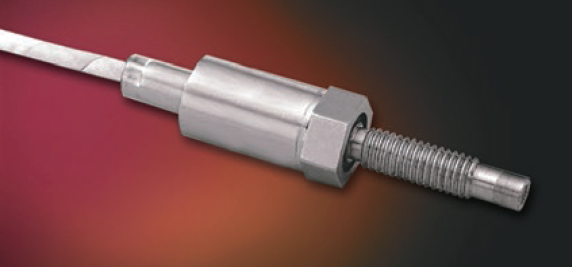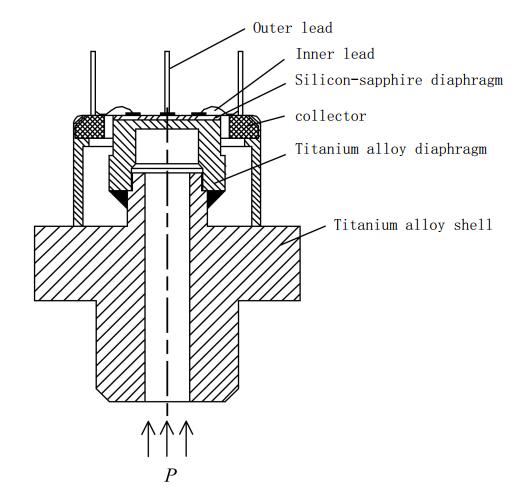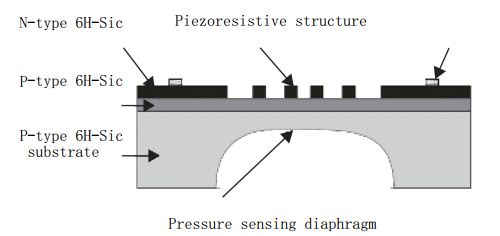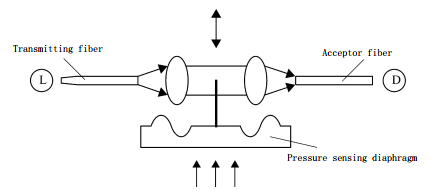Research status and development trend of high temperature and high pressure sensor
High pressure measurement at high temperature has broad application prospects in industry, aerospace, metallurgy, petroleum exploration and other fields. For example, in the aerospace field, the high-temperature pressure sensor can be used in the harsh environment of high temperature and high pressure, such as rocket engine, aircraft engine, heavy gas turbine, etc., to realize the monitoring and health assessment of their operation status. In the field of petrochemical industry, it can be used to monitor the underground oil temperature and pressure, and then provide data support for oil exploitation.
Generally speaking, when the pressure range is between 10 and 100 mpa, it is called large pressure, and the pressure greater than 100 mpa is super large pressure. High temperature pressure sensor refers to the pressure sensor that can work normally at an environment higher than 125℃.
In recent years, with the development of MEMS technology, micromechanical pressure sensors have been widely used because of their advantages of small size, low power consumption and low cost. However, when this kind of sensor is used at more than 120℃, the performance of the sensor will be sharply decreased due to the leakage of PN junction, which will lead to failure. Therefore, how to combine the advantages of MEMS technology with the existing technology, improve the process, select new high temperature resistant materials, and then overcome the above shortcomings of MEMS sensor, has become the priority among priorities at home and abroad. Great progress has also been made in this research, with the development of new sensors made from combinations of various types of materials.
With the sensor sensor material as the classification target, Aiming at the commonly used several kind of high temperature pressure sensor (including polysilicon high temperature pressure sensor, SOI (monocrystalline silicon pressure sensor, SOS (silicon sapphire) high temperature pressure sensor, SiC high temperature pressure sensor and optical fiber high temperature pressure sensor), the working principle, research status at home and abroad and so on are expounded.
1. Research status of high temperature and high pressure sensors
1.1 Polysilicon high temperature and pressure sensing
The polycrystalline silicon high-temperature pressure sensor mainly uses SiO2 as dielectric film to replace PN junction, so as to realize electrical isolation. The structural schematic diagram of the sensor is shown in Figure 1. The working principle of the sensor is similar to that of the silicon piezoresistive pressure sensor, which uses the monocrystalline silicon diaphragm as the sensitive element, converts the pressure value into the stress change of the diaphragm, and converts the change into voltage signal through the varistor, so as to realize the measurement of pressure. Because the properties of monocrystalline silicon are greatly affected by temperature, the temperature range of diffused silicon piezoresistive pressure sensor based on monocrystalline silicon is greatly limited. The polycrystalline silicon film as piezoresistive sensitive material can greatly broaden the temperature range of the sensor. In the production of the sensor, LPCVD (low pressure vapor deposition) process is used to make polysilicon film on SiO2, and then the diffusion process is used to make the varistor based on polysilicon material. Because the PN junction isolation is replaced by SiO2 dielectric isolation, the leakage of the device at high temperature is reduced, and the working temperature of the sensor is increased.

Figure 1. Working principle of polysilicon MEMS high pressure sensor
At present, only Philips (Netherlands) and Fox-boro (USA) have developed polycrystalline silicon high temperature pressure sensor products abroad. The polycrystalline silicon high temperature pressure sensor with operating temperature range of -40 ~ 180℃ was developed by Peking University in 2003, and the zero temperature drift of the sensor is less than that of the traditional pressure sensor. The polycrystalline silicon pressure sensor with high temperature resistance up to 220 ℃ was developed by Tianzhou University in 2001. The test results show that the comprehensive accuracy of the polycrystalline silicon pressure sensor is up to 0.1% Fs~ 0.2% Fs, and the absolute value of the sensitivity temperature coefficient is less than 3 × 10-4 / ℃
The polycrystalline silicon pressure sensor has the advantages of simple technology, IC compatibility, and easy batch production of chips. However, because the structure of polycrystalline silicon high temperature pressure sensor varistor and stress film is composite film, the additional stress will be caused by the mismatch of thermal expansion coefficient of different materials, which will affect the high temperature characteristics of the sensor. How to select the appropriate material and process optimization is an important development direction of the sensor in the future.
1.2 SOI pressure sensing
SOI pressure sensor mainly takes advantage of the characteristics of high production process of SOI material and small additional stress in the bonding process (substrate silicon and SiO2 directly bond, no other transition layer, to avoid additional stress), so it is used as a sensitive material. How it works is shown in Figure 2. The sensor works similarly to silicon piezoresistive pressure sensing. Because SOI material has the characteristics of self-isolation, electromagnetic radiation resistance, good stability, high temperature resistance and so on, it overcomes the shortcomings of traditional silicon piezoresistive pressure sensor which is difficult to adapt to high temperature environment. At present, some foreign companies have developed SOI high temperature pressure sensor products. For example, Colette Semiconductor Products Co., Ltd. developed an ultra-high temperature pressure sensor using silicon wafer bonding and reverse corrosion technology (as shown in Figure 3), whose operating temperature is -65 ~ 750℃. The French silicon technology device research Center has developed a number of SOI high temperature pressure sensor products, the highest temperature up to 500℃.

Figure 2. Working principle of SOI pressure sensor

Figure 3. SOI high-temperature pressure sensing from Colette Semiconductor Products
The domestic research on SOI high temperature pressure sensor is still in the experimental stage. In 2001, Huang Yiping et al. from Fudan University prepared the SOI material with the improved processing technology, and applied the material to the pressure sensor with double island. beam-membrane structure. The working temperature could reach 300℃, and the experiment showed that the sensitivity of the sensor could reach 63mV. Zhang Yushu et al. from Hebei University of Technology made SOI high temperature pressure sensor in 2006. Under the condition of 0 ~ 1MPa, the working temperature can reach 220℃. North University of China [21] and the 13th Research Institute of China Electronics Science and Technology Group Corporation have developed high-temperature pressure sensors which can be used in various fields by using MEMS related technologies respectively.
Compared with other types of sensors, the SOI pressure sensor has the advantages of easy compatibility with CMOS process, high degree of integration, and wide test range (up to 1000MPa). However, SOI sensor has a high requirement on the production process, which leads to its relatively difficult processing, which limits the development of the sensor to a certain extent, but it is also the main development direction of this kind of sensor.
1.3 SOS High temperature and pressure sensing
SOS high temperature pressure sensor is usually made of heteroepitaxial growth of monocrystalline silicon film on sapphire as an elastomer as sensitive diaphragm, which is of double diaphragm structure. The sensor has the characteristics of small nonlinear, high temperature resistance, corrosion resistance and large range. The schematic diagram of its working principle is shown in Figure 4. In order to overcome the influence of high temperature on the sensor, the sensor core sensor is composed of two diaphragm structure: titanium alloy diaphragm and sapphire diaphragm. The sapphire diaphragm is fixed on the titanium alloy diaphragm by fusion welding process. A monocrystalline silicon thin film is grown on sapphire substrate by heteroepitaxy process, and silicon strain resistance is processed on the silicon thin film by semiconductor diffusion process. The resistance bridge is formed by silicon resistance. Sapphire is composed of single crystal insulator elements, which does not suffer from hysteresis, fatigue and creep. At the same time has very good elasticity and insulation characteristics (within 1000 ℃), is not sensitive to temperature changes, even in high temperature conditions also has good working characteristics, so can be used in a variety of harsh high temperature environment.

Figure 4 Working principle of SOS high temperature pressure sensor
In such sensor research, the United States currently dominates. SENSONETICS 'SOS pressure sensors measure from 0~0.5PSI to 0~ 50,00psi and operate at -40 ~ 350 ° C with an accuracy of 0.25%. The GS4200 series titanium/silicon-sapphire pressure transmitter produced by ESI Company in the UK has a measuring range of 0 ~ 0.5bar to 0 ~ 400bar and an operating temperature range of -50 ~ 125℃. The comprehensive accuracy is better than 0.25%FS and the error is less than 1.5% at -20 ~ 70℃. The SOS pressure sensor with a range of 0~ 0.1MPa to 0~250MPa was developed by the Russian State thermal instrument Institute. The working temperature range was -50 ~ 350℃, and the accuracy reached 0.25%.
Domestically, the 19th Research Institute of China Electronics Science and Technology Group Corporation developed SOS pressure sensors with a range of 60MPa and 100MPa respectively in 2017 through the introduction of relevant Russian technologies and late independent innovation. The working temperature range is -50 ~ 350 ℃, the full-scale output is ≥100mV, and the accuracy is better than 0.1%. The hysteresis and repeatability were better than 0.05% FS. In 2011, the SOS pressure sensor with a measuring range of 0.6MPa and operating temperature range of -55 ~ 200℃ was developed by using double diaphragm structure.
Although the SOS pressure sensor has good mechanical properties, the mass production of the sensor is limited largely due to the low yield of the strain film preparation. At the same time, due to the lattice mismatch between epitaxial monocrystalline silicon film and sapphire, its long-term stability is poor. How to overcome the above problems is very important for the future development of such sensors.
1.4 SiC high temperature pressure sensor
SiC high temperature pressure sensor using SiC material as a sensitive element, the sensor has a wide band gap structure, high breakdown voltage high thermal conductivity, good radiation resistance, less leakage and high temperature stability. The initial report of this kind of sensor was completed by Ziermann et al in 1997. Its simple structure is shown in Figure 5. Because the sensor uses 6H-SiC as the base material, the influence of temperature on the sensor is greatly reduced, and the test performance of the sensor under high temperature is improved. SiC piezoresistive pressure sensor with working temperature up to 400℃ was made by Western Reserve University in 2004. In 2008, ChenLi, the same school, designed a new SiC structure using LTO as the insulation layer, the working temperature is raised to 574℃; At present, the United States NASA (National Aeronautics and Space Administration) and the United States Colette Semiconductor Products Co., Ltd. using 6H-SiC materials to develop high temperature pressure sensor products up to 500 ℃; In 2015, the National University of Malaysia developed the 3C-SiC high temperature pressure sensor, which has a working temperature of 500 ℃ and a pressure range of 5 MPa. The 13th Research Institute of China Electronics Science and Technology Corporation developed the SiC high temperature pressure sensor chip in 2017, and processed the MEMS piezoresissive SiC pressure sensor. The experiment shows that the nonlinear index of the sensor reaches 1.054% under the working temperature of 550℃ and the range of 700kPa. The sensitivity reaches 0.005 mV/(kPa·V). Beijing Great Wall Aeronautical Measurement and Control Technology Research Institute and Beijing University of Aeronautics and Astronautics carried out the research of SiC high temperature pressure sensor based on Fabry-Pert cavity, the highest temperature resistance of 1200℃.

Figure 5 SiC high temperature pressure sensing
1.5 Optical Fiber high-temperature pressure sensor
Fiber optic pressure sensors were first used to measure blood vessel pressure in the 1970s; It was not until the 1990s that fiber-optic Fabry-Perot pressure sensors were used in the high-temperature field. Due to the high temperature resistance characteristic of optical fiber material itself, the sensor can work in high temperature environment, and has the characteristics of small size, light weight, anti-electromagnetic interference and electrical insulation. Its working principle is shown in Figure 6. This kind of sensor converts the displacement of the sensitive diaphragm into the change of the frequency, intensity and phase of the modulated light transmitted in the fiber through the optical fiber, and calculates the pressure by detecting the change of these signals. Because of the high temperature resistance of optical fiber material, optical fiber pressure sensor can adapt to high temperature working environment. This kind of sensor has the advantages of small size, light weight, anti-electromagnetic interference, electrical insulation, so that it can be used in some special occasions with harsh environment. American Piezoelectric Co., LTD., Enderfolk Company, Germany HBM company have produced corresponding products. In 2006, Dalian University of Technology designed a fiber optic high temperature pressure sensor system for high temperature oil well measurement, the sensor measurement resolution of 0.002%. In the range of 0~20MPa pressure, the influence on the temperature measurement is less than 0.2%, in the range of 20 ~ 300℃ temperature, the influence on the pressure measurement is less than 1%. In 2014, Beijing Institute of Technology proposed a micro-nano fiber Fabry-perot interferometric pressure sensor based on femtosecond laser processing technology, which successfully carried out pressure and temperature tests in the temperature range from room temperature to 1100℃.

Figure 6. Working principle of optical fiber pressure sensor
Fiber optic high temperature pressure sensor has the characteristics of wide measuring range, but because of the difficulties in production, high cost, low measurement accuracy, the application of this kind of sensor is limited, which is also an important research direction of this kind of sensor in the future.
2. Temperature compensation method of high temperature and large pressure sensor
The temperature effect has great influence on the measurement accuracy of pressure sensor. In addition to the use of high-performance materials and design methods to avoid such effects, temperature compensation is also an important research content.
At present, there are three methods to improve the testing performance of the sensor: (1) Material selection and structural optimization design of the sensor. By selecting the material sensor with good performance and using theoretical analysis and finite element simulation technology, the structure is optimized; ② By choosing high-energy components and by designing good performance, strong anti-noise ability of components, make relevant test circuit, to achieve high performance sensors; ③ Mainly aiming at the problem that the performance of the sensor varies greatly with the temperature under the high temperature working environment, the corresponding temperature compensation structure and algorithm are designed to improve the test performance of the sensor. This section mainly elaborates the research status of temperature compensation algorithm.
2.2 Domestic research
The temperature compensation method is also studied in China. In 2014, the State Key Laboratory of Mechanical Manufacturing Systems Engineering at Xi 'an Jiaotong University used digital methods to compensate the temperature drift of pressure sensors. The accuracy, linearity, zero temperature coefficient and sensitivity temperature coefficient of the sensor are respectively changed from 2.57% FS, 2.49% FS, 8.1 × 10-5 / ℃ and 29.5 × 10-5 / ℃ before compensation. Increased to 0.13%FS, 0.15%FS, 1.17× 10-5 / ℃ and 2.1× 10-5 / ℃ after compensation. In 2013, Soochow University et al. used a high-order temperature compensation model to compensate the piezoresistive pressure sensor, and the maximum error of the compensated sensor was 0.313% FS. In February 2016, Ding Miaogao et al. from Shanghai Institute for Advanced Studies, Chinese Academy of Sciences designed a temperature supplement system for bridge sensor. In the temperature range of 20 ~ 70℃, the maximum full-scale error of the sensor decreased from 14.63% FS before compensation to 0.334% FS after compensation. In 2017, Beijing Great Wall Institute of Aeronautical Measurement and Control Technology and Beijing University of Aeronautics and Astronautics cooperated to study the temperature compensation of large range silicon sapphire pressure sensor with a range of 28MPa. In the temperature range of -20 ~ 120℃, the measurement accuracy of the sensor increases from 2.25% before compensation to 0.1% after compensation. In the temperature range of 120 ~ 250℃, the measurement accuracy of the sensor increases from 8.44%FS before compensation to 0.34%FS after compensation, which greatly improves the measurement accuracy of the sensor under high temperature conditions.
3. Conclusion and prospect
3.1 Conclusion
(1) In extremely harsh environments such as high temperature and high pressure, the materials of commonly used sensors and sensitive elements can not meet the test requirements. Based on this, many new sensor materials (such as polysilicon, SOI materials, sapphire, optical fiber materials, etc.) are applied to the sensor, greatly improving the high temperature resistance performance of the sensor.
② At present, the pressure measuring range of high temperature large range pressure sensor can reach 1000MPa, and the temperature measuring range can reach 1200℃. The temperature effect is still the main reason that affects the measurement accuracy. At present, the temperature compensation method is mainly used to improve the measurement accuracy
3.2 Outlook
① Improvement of technological conditions.
The production process is one of the important factors that trouble the development of high temperature and high pressure sensors. At present, the factors restricting the development of sensors, in addition to the materials of sensitive components, the production process is also the main influencing factor, constantly improve the production process of sensors, improve the performance of sensors, has been an important factor in the development of high temperature and pressure sensors in the future.
② High temperature pressure measurement based on non-contact method. Due to the non-contact high temperature measurement method (such as thermal radiation method, photoelectric detection method, etc.) has the characteristics of non-contact, it will become one of the directions of high temperature and high pressure measurement in the future.
③ Temperature compensation technology of high temperature and large pressure sensor based on new structure.
At present, the research on high temperature and high pressure sensors mainly focuses on material selection and temperature compensation methods. At the same time, how to improve the sensor test accuracy and reduce the influence of temperature effect from the aspect of structural design through clever structural design will also be one of the important research directions of this kind of sensor
References:
[1] Li Xinxin. Recent Progress of MEMS Pressure Sensor Technology [J]. Journal of Functional Materials and Devices, 2013,19 (4) : 172-176.
[2] Zhang Xiaoli, Chen Shuijin. Research Status and Development of High Temperature Pressure Sensor [J]. Sensors and Microsystems, 2011, 30 (2) : 1-4.
[3] Wu Linghui, Xu Dong. Design of High Temperature and Harsh Environment Pressure Sensor [J]. Applied Science and Technology, 2018,45 (4) : 142-146
[4] Wang Jinsong, Chi Xiaozhu. Development and Trend of Special Sensors [J]. Measurement Technology, 2019,39 (4) : 59-62. (in Chinese)
[5] Zhang Wei, Yao Suying, Zhang Shengcai, et al. Current situation and prospect of high temperature pressure sensors
[J]. Instrument Technique and Sensor, 2002 (4) : 6-8.
[6] Luo Tao. Design and Integration of Capacitive Multi-parameter Passive LTCC Sensor [D]. Taiyuan: North University of China, 2015. (in Chinese)
[7] SUSKI J, MOSSER V, GOSS J. Polysilicon SOI pressuresen sor [J]. Sensorsand and Actuators, 1989 (3/4) : 405-414.
[8] Huo Mingxue, Liu Xiaowei, Zhang Dan, et al. High temperature piezoresistive effect of polysilicon films
[J]. Chinese Journal of Semiconductors, 2005,26 (11) : 2115-2119.
[9] Wang Jian, Chuai Rongyan, He Xiaoyu, et al. Piezoresistive Pressure Sensor of polysilicon nano Film [J]. Instrument Technique and Sensor, 2009 (9) : 6-9.
[10] He Wentao, Li Yanhua, Zou Jiangbo, et al. Research Status and Development Trend of High Temperature Pressure Sensor [J]. Telemetry and Remote Control, 2016,37 (6) : 61-71.
[11] Zhou Jian, Hou Zhanqiang, Xiao Dingbang. Research Progress of Pressure Sensor in Extreme Environment [J]. National Defense Science and Technology, 2015,36 (4) : 15-19.
[12] Zhang Wei, Wang Yangyuan. Research on Polycrystalline Silicon Integrated High Temperature Pressure Sensor [J]. Acta Electronica Sinica, 2003,21 (11) : 1737-1739.
[13] Liu Yanyan, Yao Suying, Zhang Shengcai, et al. High performance high temperature pressure sensor
[J]. Semiconductor Technology, 2001,26 (5) : 13-16.
[14] Guo Yugang, Rao Hao, Tao Maojun. MEMS SOI high temperature pressure sensor chip
[J]. Sensors and Microsystems, 2018,37 (11) : 92-95.
[15] Li Yuling, Wang Mingwei, Zhang Linchao. Research on Residual Stress of Anode Bonding in SOI Pressure Sensor [J]. Sensors and Microsystems, 2018,37 (11) : 18-21.
[16] Yang Jiaoyan, Liang Ting, Li Xin, et al. High Temperature Pressure Sensor Based on SOI Island Membrane Structure [J]. Micro-nano Electronics Technology, 2018,55 (9) : 635-640.
[17] Zhang Yushu, Zhang Weilian, Zhang Shengcai, et al. Research Status of SOI High Temperature Pressure Sensor [J]. Journal of Hebei University of Technology, 2005, 34 (2) : 984-987.
[18] Li Ce. Current status and development trend of sensors for harsh environmental conditions
[J]. Measurement and Measurement Technology, 2005,32 (7) : 9-11.
[19] Huang Yiping, Zhu Shiyang, Li Aizhen, et al. Intelligent Stripping SOI High Temperature Pressure Sensor [J]. Chinese Journal of Semiconductors, 2001,22 (7) : 924-928.
[20] Zhang Yushu. Research on High Temperature Pressure Sensor of SOI [D]. Tianjin: Hebei University of Technology, 2006. (in Chinese)
[21] Wang Xiangwen. Development of Small Pressure Difference Sensor with High Temperature Resistance [J]. Measurement and Measurement Technology, 2013,40 (5) : 11-12.
[22] Duan Lei. Novel Pressure Sensor Technology with Wide Temperature Zone [J]. Instrument Technique and Sensor, 2009 (12) : 17-18.
[23] Lu Chao, Huang Manguo, Li Xin, et al. Research on Temperature Compensation of Silicon Sapphire Pressure Sensor [J]. Measurement and Control Technology, 2017,36 (4) : 113-116.
[24] Pang Tianzhao, Yan Zilin, Tang Fei, et al. Research Progress and Prospect of SIC High temperature Pressure Sensor [J]. Noise and Vibration Control, 2011 (1) : 170-174.
[25] Yu Yi, Yu Jia, Jing Bin. Analysis on the Development of High Temperature Pressure Sensor [J]. Science and Technology and Innovation, 2015 (17) : 42-42.
[26] Li Shuai, Wang Jianping. Structure Simulation and Optimization of sic Pressure Sensor [J]. Electronic World, 2017 (22) : 12-14.
[27] He Hongtao, Wang Weizhong, Du Shaobo, et al. A Novel MEMS Piezoresistive SiC High Temperature Pressure Sensor [J]. Micronano Electronics Technology, 2015,52 (4) : 233-239.



